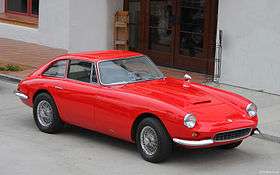Apollo (1962 automobile)
The Apollo was an American sports car/personal automobile, initially manufactured from 1962 to 1964 by International Motor Cars in Oakland, California.
| Apollo | |
|---|---|
 1965 Apollo 5000 GT Coupe | |
| Overview | |
| Manufacturer | International Motor Cars |
| Also called | Vetta Ventura |
| Production | 88 |
| Model years | 1962 - 1965 |
| Assembly | Oakland, California, United States |
| Designer | Ron Plescia & Franco Scaglione |
| Body and chassis | |
| Class | Sports Car |
| Body style | fastback coupe or convertible |
| Related | Carrozzeria Intermeccanica |
| Powertrain | |
| Engine | |
| Transmission | 4 speed manual (automatic optional) |
| Dimensions | |
| Wheelbase | 2,464 mm (97.0 in)[1] |
| Length | 4,445 mm (175.0 in) |
| Width | 1,676 mm (66.0 in) |
| Height | 1,270 mm (50.0 in) |
| Curb weight | 1,030 kg (2,271 lb) |
| Chronology | |
| Predecessor | None |
| Successor | None |
Engineered by Milt Brown and designed by Ron Plescia, it featured handmade Italian aluminum coachwork by Intermeccanica, with a choice between two-seater convertible or fastback styles. Power came from a 215 cu in (3.5 l) or 300 cu in (4.9 l) Buick[2] engine mated to a 4-speed manual.
The initial company built 42 cars before suspending production while seeking new financing. IMC allowed the sale of body/chassis units to Vanguard Motors in Dallas, Texas, to produce cars under the Vetta Ventura name. These were made until 1966 as a stop-gap measure to keep the carrozzeria (body producer Intermeccanica) in business until new backers were found. Other production arrangements followed.
A total of 88[3] have been produced to date by all entities.
History
Frank Reisner, a former chemical engineer born in Hungary, raised in Canada and educated in America,[4] established a company that later produced complete bodies -- painted and trimmed -- for the Apollo as well as the Texas-built Vetta Ventura (which was the same car with a different name). Reisner, on holiday in Italy in 1959, decided that he loved Turin and set up shop there as Intermeccanica producing tuning kits for Renaults, Peugeots, and Simcas.
The Apollo project was the dream of a young California engineer, Milt Brown, who desired to build an American answer to European GTs, such as the Aston Martin DB4 and Ferrari coupes. Brown, who was looking for a coachbuilder, met Reisner at the Monaco Grand Prix in 1960. A deal was made and the first Apollos were built by early 1963 by Brown's International Motor Cars. Intermeccanica hand formed and trimmed the steel bodies in Turin, Italy, and then shipped them by sea to Oakland, California, where the drive train was installed. The prototype's design was by Milt Brown's friend, Ron Plescia, but the nose was too long and the rear vision limited, so Reisner commissioned former Bertone stylist Franco Scaglione to revise it.
The finished car, sold by Brown's International Motorcars of Oakland, was well received and had famous owners such as Pat Boone. The base price was $6000 and the top speed was claimed to be 150 mph (240 km/h).
A prototype 2 + 2 was shown in New York in 1965. It was shown again in 1966 as the Griffth GT.[4]
International Motor Cars sold 42 cars (40 coupes and one spyder, including the prototype) before production stopped in mid-1964 due to lack of financing. IMC then made a contract with Reisner (to keep his operation going) allowing Intermeccanica to supply body/chassis units to Fred Ricketts, owner of Vanguard Industries, an aftermarket supplier of auto air conditioners in Dallas, Texas. Vanguard sold it as the Vetta Ventura. The intent was to give IMC time to find new financing as well as keep Intermeccanica alive.
Vanguard built only 11 cars, with shop foreman Tom Johnson purchasing the leftover 11 body/chassis units and completing them as late as 1971.
A third attempt to produce the Apollo was by attorney Robert Stevens. His Apollo International company of Pasadena, California completed only 14 cars, with foreman Otto Becker finishing another six. Four body chassis/units were never claimed by Apollo International and were sold by US Customs to Ken Dumiere.
A pair of Apollo 3500 GTs were used to portray the Thorndyke Special race car which was featured in The Love Bug, a 1968 Disney movie. One of the pair has been fully restored.[5][6]
Reisner later developed projects such as the Griffith, the Murena GT, and the Italia by Intermeccanica. Intermeccanica went on to produce the Veltro 1500, the Griffin (which was a version of the prototype Apollo 2+2), the Phoenix, and the Omega among others.
Specifications
| Engine | Max power | Transmission | Wheelbase | Length | Weight |
|---|---|---|---|---|---|
| 215CID Buick V8 | 225 hp (168 kW) | 4-speed | 97 in (2,464 mm) | 177 in (4,496 mm) | 2,540 lb (1,150 kg) [1] |
References
- "1963 Apollo GT Convertible performance data, specs & photo". Automobile-catalog.com. Retrieved 2011-11-20.
- Gunnell, John A. (ed.). Standard Catalog of American Cars 1946-1975. krause publications. ISBN 0-87341-027-0.
- Northrup, Robb Apollo GT: The American Ferrari
- Rogliatti, Gianni (Spring 1971). "Frank Reisner's Intermeccanica - One of the Few That Made it". Automobile Quarterly. 40 East 49th Street, New York, NY 10017 USA: Automobile Quarterly. 11 (3): 309–311. LCCN 62004005.CS1 maint: location (link)
- "1963 Apollo 3500 GT in "The Love Bug, 1968"". IMCDb.org. Retrieved 2011-11-20.
- "The Thorndyke Special". Barn Finds. 2013-11-07. Retrieved 2016-12-23.